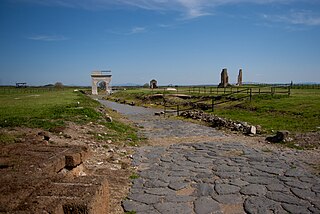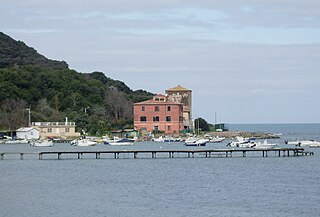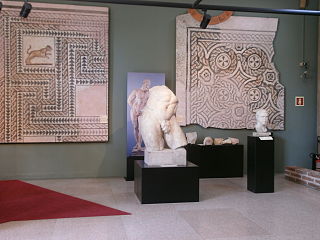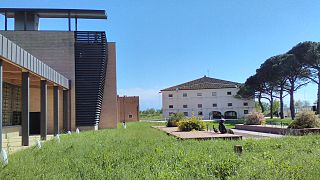Exhibition
The museum aims to illustrate the history of the territory and the use of its resources, in particular mining. The exhibits are dated from the prehistoric to the Etruscan and Roman times.
The organization within the museum follows the chronological history of the area: the first rooms are devoted to prehistoric artifacts (from the Stone Age to the Bronze Age), the center rooms to the Etruscan period, and the last to the Roman period and late antiquity. Apart from artifacts, the different periods are also illustrated by a series of panels that cover the walls of the rooms, and in some cases around the windows. There are also exhibited models of production facilities (ovens and proto-historic Etruscans), a tomb, and the cargo of a ship.
The Anfora Baratti
The most important artifact in the museum is the preserved silver Anfora of Baratti, accidentally found at sea in the nets of a fishing vessel in the waters of the Gulf of Baratti in 1968 and patiently restored. This vase, dating from the 4th century BC, is decorated with 134 medallions depicting myths and pagan gods, linked to the worship of the goddess Cybele.
Not only is this a rare piece of silverware, but it is also an example illustrating the persistence of pagan culture among some of the Roman Empire after the conversion to Christianity.
Other finds
Other important items at the museum include the fish mosaic, depicting a shipwreck scene and dating to the 2nd century BC, the Tesoretto Rimigliano (a collection of Roman coins found at sea), the cargo of the wreck of Pozzino (from the 2nd century BC), and several sets of Etruscan tombs. Among the tombs are reported to be the Tomb of Goldsmiths (7th century BC), the Tomb of the Bidder Bronzetto (6th-4th century BC) and the Tomb of the Cave 14 (4th-3rd century BC) found during an excavation in 1997-1998.
A stone engraving of a bison in prehistoric times is another item that stands out within the museum's collection.

Adria is a town and comune in the province of Rovigo in the Veneto region of northern Italy, situated between the mouths of the rivers Adige and Po. The remains of the Etruscan city of Atria or Hatria are to be found below the modern city, three to four metres below the current level. Adria and Spina were the Etruscan ports and depots for Felsina. Adria may have given its name during an early period to the Adriatic Sea, to which it was connected by channels.

Piombino is an Italian town and comune of about 35,000 inhabitants in the province of Livorno (Tuscany). It lies on the border between the Ligurian Sea and the Tyrrhenian Sea, in front of Elba Island and at the northern side of Maremma.

Paestum was a major ancient Greek city on the coast of the Tyrrhenian Sea in Magna Graecia. The ruins of Paestum are famous for their three ancient Greek temples in the Doric order, dating from about 550 to 450 BC, which are in an excellent state of preservation. The city walls and amphitheatre are largely intact, and the bottom of the walls of many other structures remain, as well as paved roads. The site is open to the public, and there is a modern national museum within it, which also contains the finds from the associated Greek site of Foce del Sele.

The National Archaeological Museum of Naples is an important Italian archaeological museum, particularly for ancient Roman remains. Its collection includes works from Greek, Roman and Renaissance times, and especially Roman artifacts from the nearby Pompeii, Stabiae and Herculaneum sites. From 1816 to 1861 it was known as Real Museo Borbonico.

Vulci or Volci was a rich Etruscan city in what is now northern Lazio, central Italy.

Populonia or Populonia Alta today is a frazione of the comune of Piombino. As of 2009 its population was 17. Populonia is especially noteworthy for its Etruscan remains, including one of the main necropolis in Italy, discovered by Isidoro Falchi.

Etruscan art was produced by the Etruscan civilization in central Italy between the 10th and 1st centuries BC. From around 750 BC it was heavily influenced by Greek art, which was imported by the Etruscans, but always retained distinct characteristics. Particularly strong in this tradition were figurative sculpture in terracotta, wall-painting and metalworking especially in bronze. Jewellery and engraved gems of high quality were produced.

The National Archaeological Museum of Florence is an archaeological museum in Florence, Italy. It is located at 1 piazza Santissima Annunziata, in the Palazzo della Crocetta.

The Museo Nazionale della Magna Grecia, Museo Archeologico Nazionale di Reggio Calabria or Palazzo Piacentini is a museum in Reggio Calabria, southern Italy, housing an archaeological collection from sites in Magna Graecia.

Baratti is a village frazione of the comune of Piombino in the Province of Livorno, with roughly only 15 residents.

The Archaeological Park of Baratti and Populonia is located in the township of Piombino and covers about 80 hectares between the slopes of the promontory of Piombino and the Gulf of Baratti coast. It is part of The Parks of Val di Cornia and was opened in 1998 for visitors to view some of the archaeological sites and remains found in the new digs archaeological conducted in the area since 1996.

Gino Vinicio Gentili was an Italian archaeologist.
The archaeological area of Poggio del Molino is situated on the northern side of a headland that acts as a watershed between the beach of Rimigliano in the north, and the Gulf of Baratti in the south; to the northern border of the territory administered by the city of Piombino in the Italian Province of Livorno. The structure of Roman age spreads over a high plateau of about 20 m asl which dominates, in the west, the stretch of a sea between San Vincenzo and Elba and to the east, the metalliferous hills and plains of the Campiglia lagoon. The top of the hill is occupied by the beautiful Villa del Barone, built in 1923 by Baron Luigi De Stefano and Assunta Vanni Desideri, the daughter of Eugenio. From a paper of the 16th century, the "Bandita di Porto Baratti", and some archival documents we know that the Poggio owes its name to the mill which was a part of Torre Nuova, the building of coastal defense and a lookout built in the early sixteenth century by Cosimo I de' Medici, on the slopes of the promontory.

The Archaeological Museum of Milan is located in the ex-convent of the Monastero Maggiore, alongside the ancient church of San Maurizio al Monastero Maggiore, with entrance on Corso Magenta.

The Antonino Salinas Regional Archeological Museum is a museum in Palermo, Italy. It possesses one of the richest collections of Punic and Ancient Greek art in Italy, as well as many items related to the history of Sicily. Formerly the property of the Oratory of Saint Philip Neri, the museum is named after Antonino Salinas, a famous archaeologist and numismatist from Palermo who had served as its director from 1873 until his death in 1914, upon which he left it his major private collection. It is part of the Olivella monumental complex, which includes the Church of Sant'Ignazio all'Olivella and the adjoining Oratory.

The tomb known as the Regolini-Galassi tomb is one of the wealthiest Etruscan family tombs in Caere, an ancient city in Italy approximately 50–60 kilometres (31–37 mi) north-northwest of Rome. The tomb dates to between 650 and 600 BC, most likely in the 640s BC. Based on the evidence of the tomb's architecture and its contents, it was built by a wealthy family of Caere. The grave goods included with the two decedents included bronze cauldrons and gold jewellery of Etruscan origin in the Oriental style. The tomb was discovered in 1836 in modern-day Cerveteri in an undisturbed condition and named after the excavators, general Vincenzo Galassi and the archpriest of Cerveteri, Alessandro Regolini. Both of these men had previous experience opening and excavating tombs in the area of Caere.

The Archaeological Civic Museum of Bologna is located in the fifteenth-century Palazzo Galvani building at Via dell'Archiginnasio 2 postal code 40124 Bologna, once known as the Hospital of Death. Founded in September 1881 by the merging of two separate museums: the one belonging to the University of Bologna – heir of the Room of Antiquity belonging to the Academy of Sciences founded by Luigi Ferdinando Marsili in (1714) – and that belonging to the City of Bologna (enriched by the antique collection of Artist Pelagio Palagi and the large amount of finds from excavations conducted in and around Bologna during these times.

The Tarquinia National Museum is an archaeological museum dedicated to the Etruscan civilization in Tarquinia, Italy. Its collection consists primarily of the artifacts which were excavated from the Necropolis of Monterozzi to the east of the city. It is housed in the Palazzo Vitelleschi.

The National Archaeological Museum of the Marche Region is an archaeological museum in Ancona, Marches, Italy. It is located in the Palazzo Ferretti, and 13,195 people visited the collections in 2015.

The National Archaeological Museum of Altino is an Archaeology museum located in Altino, in the municipality of Quarto d'Altino, in the Metropolitan City of Venice, Italy, next to archaeological site of Altinum.




















